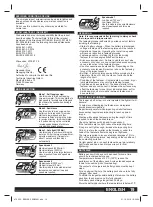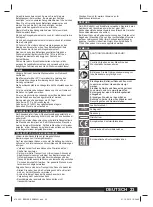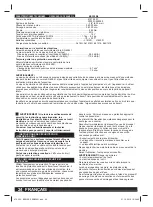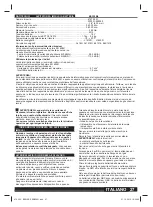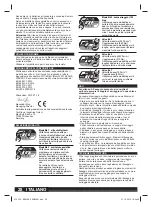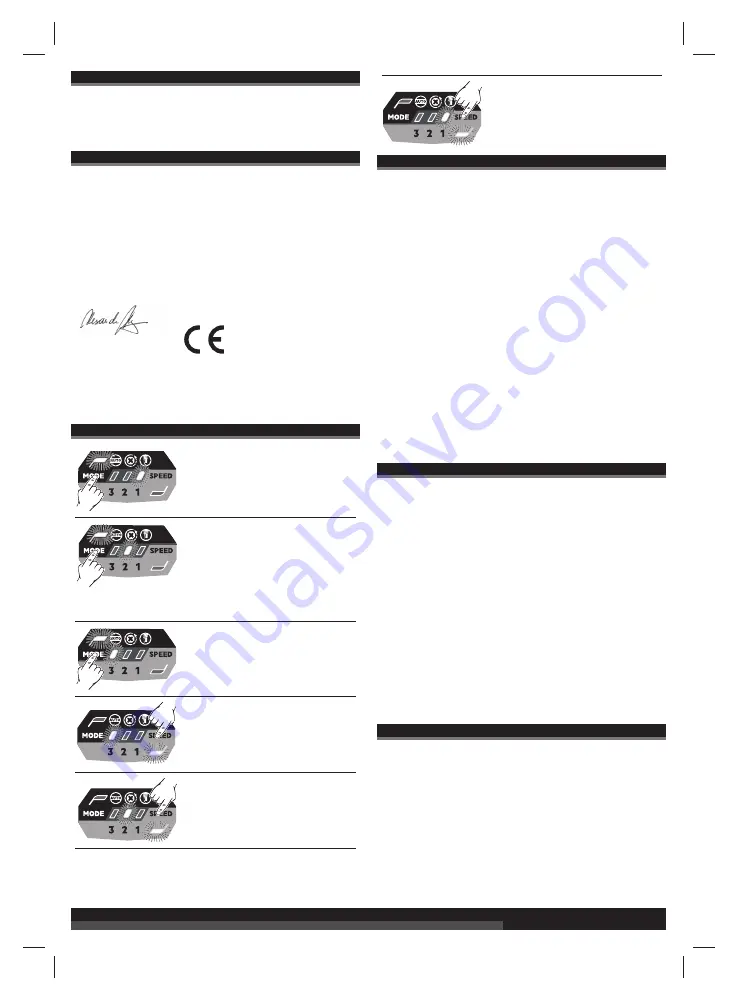
19
ENGLISH
SPECIFIED CONDITIONS OF USE
The cordless impact screwdriver can be used to tighten and
loosen nuts and bolts wherever no mains connection is
available.
Do not use this product in any other way as stated for
normal use.
EC-DECLARATION OF CONFORMITY
We declare under our sole responsibility that the product
described under “Technical Data” ful
fi
lls all the relevant
provisions of the directives 2011/65/EU (RoHS), 2014/30/
EU, 2006/42/EC and the following harmonized standards
have been used:
EN 62841-1:2015
EN 62841-2-2:2014
EN 55014-1:2017
EN 55014-2:2015
EN IEC 63000:2018
Winnenden, 2019-07-18
Alexander Krug
Managing Director
Authorized to compile the technical
fi
le.
Techtronic Industries GmbH
Max-Eyth-Straße 10
71364 Winnenden
Germany
MODE SELECTION
1 x
Mode 1: Self tapping screw
Use this mode to drive self tapping
screws into metal. This mode starts at a
high speed to facilitate hole drilling and
then lowers the speed when driving in
the screw.
2 x
Mode 2: Assistance
Use this mode to drive screws when
better control is required. This mode
starts at a lower speed and then
increases to
fi
nish driving in the screw.
In reverse direction, this mode rotates
in 6 pulses moving up to a controlled
reverse speed designed to remove
screws with damaged heads.
3 x
Mode 3: Auto tight (120 Nm)
Use this mode to avoid overdriving the
nut or bolt. After the impact screwdriver
detects a resistance, it impacts for
about 1 second and then stops
automatically.
1 x
Speed mode 3
Maximum speed (3000 min-1)
Maximum torque (280 Nm)
Use this mode to drive large fasteners
when maxmium force and speed are
required.
2 x
Speed mode 2
Medium speed (2200 min
-1
)
Medium torque (210 Nm)
Use this mode to drive medium-sized
fasteners when medium force and
speed are required.
3 x
Speed mode 1
Low Speed (750 min
-1
)
Low torque (50 Nm)
Use this mode to drive small fasteners
when lowest speed and force are
required.
OPERATION
Note: It is recommended after fastening to always check
the torque with a torque wrench.
The fastening torque is a
ff
ected by a wide variety of factors
including the following.
• State of battery charge – When the battery is discharged
voltage will drop and the fastening torque will be reduced.
• Operation at speeds – Operating the tool at low speeds
will cause a reduction in fastening torques.
• Fastening position – Holding the tool or the driving
fastener in various angles will a
ff
ect the torque.
• Drive accessory/socket – Failure to use the correct size
accessory or socket, or a non-impact rated accessory may
cause a reduction in the fastening torque.
• Use of accessories and extensions – Depending on the
accessory or extension
fi
tment can reduce the fastening
force of the impact wrench.
• Bolt/Nut – Fastening torques may di
ff
er according to the
diameter of the nut or bolt, the class of nut/bolt and the
length of nut/bolt.
• Condition of the fastener – Contaminated, corroded, dry or
lubricated fasteners may vary the fastening torques.
• Condition and base material – The base material of the
fastener and any component in between the surfaces may
e
ff
ect the fastening torque (dry or lubricated base, soft or
hard base, disc, seal or washer between fastener and
base material).
IMPACTING TECHNIQUES
The longer a bolt, screw, or nut is impacted, the tighter it will
become.
To help prevent damaging the fasteners or workpieces,
avoid excessive impacting.
Be particularly careful when impacting smaller fasteners
because they require less impacting to reach optimum
torque.
Practice with various fasteners, noting the length of time
required to reach the desired torque.
Check the tightness with a hand-torque wrench.
If the fasteners are too tight, reduce the impacting time.
If they are not tight enough, increase the impacting time.
Oil, dirt, rust or other matter on the threads or under the
head of the fastener a
ff
ects the degree of tightness.
The torque required to loosen a fastener averages 75% to
80% of the tightening torque, depending on the condition of
the contacting surfaces.
On light gasket jobs, run each fastener down to a relatively
light torque and use a hand torque wrench for
fi
nal
tightening.
BATTERIES
Battery packs which have not been used for some time
should be recharged before use.
Temperatures in excess of 50°C (122°F) reduce the
performance of the battery pack. Avoid extended exposure
to heat or sunshine (risk of overheating).
The contacts of chargers and battery packs must be kept
clean.
For an optimum life-time, the battery packs have to be fully
charged, after used.
To obtain the longest possible battery life remove the battery
pack from the charger once it is fully charged.
For battery pack storage longer than 30 days:
Store the battery pack where the temperature is below 27°C
470 322 - BSS18B6_EN62841.indd 19
470 322 - BSS18B6_EN62841.indd 19
21.10.2019 19:34:34
21.10.2019 19:34:34















